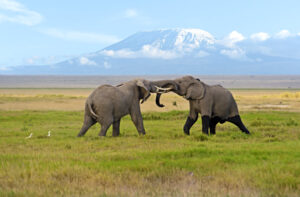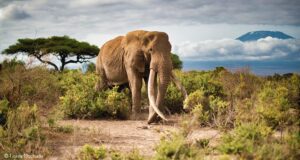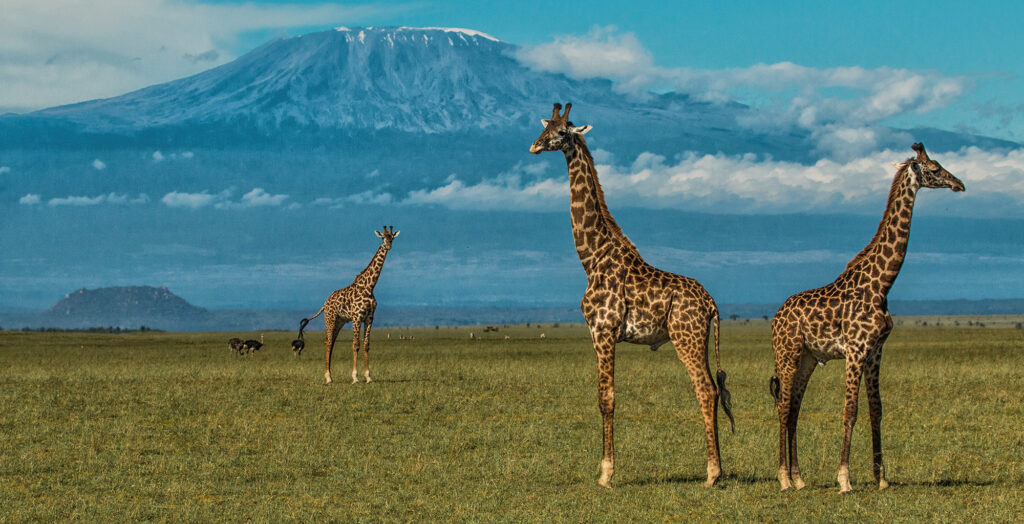Of all the magnificent creatures that roam the African continent, none captivates the human imagination quite like the elephant. These intelligent, social, and deeply emotional giants represent the very soul of the wild. And if there is one place on Earth where the essence of the elephant is not just seen, but profoundly felt, it is Amboseli National Park. While Kenya is blessed with many incredible safari destinations, Amboseli stands alone as the undisputed elephant capital of the world, offering an unparalleled window into the lives of these gentle behemoths against a backdrop of breathtaking, iconic beauty.

Amboseli National Park at a Glance
Nestled in southern Kenya, just north of the Tanzanian border, Amboseli is a relatively compact park, covering just 392 square kilometers. Yet, its size belies its immense ecological significance. The park is a land of dramatic contrasts—a seemingly arid, dusty plain punctuated by lush, green swamps that are fed by the underground aquifers of Mount Kilimanjaro. This unique ecosystem is the lifeblood of the park, attracting incredible concentrations of wildlife. But beyond its swamps and savannah, Amboseli is forever defined by its breathtaking view: the majestic, snow-capped peak of Mount Kilimanjaro, Africa’s highest mountain, which towers over the plains, providing a picture-perfect frame for every wildlife encounter.
The Elephant Capital of the World
Amboseli is home to over 1,500 African elephants, a number that has remained remarkably stable thanks to decades of dedicated conservation. What sets Amboseli apart is not just the number, but the nature of the herds. Here, you are not just likely to see a few solitary bulls; you will witness vast, thriving families. It is common to see herds of 50 to 100 individuals moving slowly across the plains, a breathtaking sight that feels like a journey back in time to a prehistoric Africa. This is one of the few places where you can truly observe the intricate social structures of elephants in their most authentic form, from tiny, clumsy calves to the immense, wise old matriarchs who lead their families with unwavering authority.

Iconic Elephant Photography with Kilimanjaro
For photographers, professional and amateur alike, Amboseli is the holy grail. The park offers what is arguably the most iconic wildlife photograph on the planet: a parade of elephants, their trunks swinging and dust rising from their footsteps, walking across the open golden plains with the magnificent peak of Mount Kilimanjaro dominating the horizon. The combination of easily observable elephants, flat terrain, and that unparalleled backdrop creates lighting and compositional opportunities that are simply impossible to find anywhere else. The image of an Amboseli elephant set against Kilimanjaro is more than a photo; it is a symbol of Africa itself.
Elephant Behavior in Amboseli
The open vistas of Amboseli provide a unique opportunity to become a silent observer of the elephant’s world. You can spend hours watching the complex dynamics of a family unit. You’ll see calves, protected in the center of the herd, learning crucial life skills by mimicking their mothers and aunties—how to dig for water, use their trunks to strip bark from trees, and navigate social hierarchies. You might witness a protective mother gently guiding her newborn, or the fascinating, gentle interaction between bulls in musth. The sparse vegetation means these intimate moments of play, communication, and teaching are often visible from a respectful distance, offering a masterclass in elephant ethology.
Amboseli Elephant Research Project (AERP)
A key reason for our deep understanding of these animals is the world-renowned Amboseli Elephant Research Project (AERP). Initiated by renowned conservationist Cynthia Moss in 1972, it is the longest-running continuous study of wild elephants in the world. The researchers know every elephant by name, understand their lineages, and have documented their lives for over five decades. This invaluable scientific work has fundamentally shaped global elephant conservation strategies. As a visitor, you benefit from this deep knowledge; your guide will often share stories about specific elephant families, turning a simple sighting into a meaningful encounter with a known individual with a rich history.
The Landscape That Favors Elephant Viewing
Amboseli’s geography is perfectly designed for spectacular elephant viewing. The vast, open savannah and flat plains provide unobstructed panoramas, making it easy to spot herds from miles away. The permanent freshwater springs from Kilimanjaro’s meltwater create permanent swamps—Enkongo Narok, Olokenya, and Longinye—that act as magnets for wildlife, especially elephants. Here, you can watch herds wade deep into the emerald-green marshes, using their trunks as snorkels while they feed on aquatic plants or playfully spray themselves and each other to cool off. The contrast of red-dusted elephants against the vibrant green swamps is another of Amboseli’s unforgettable visual signatures.
Conservation Success in Amboseli
Amboseli stands as a beacon of successful human-wildlife coexistence. Its thriving elephant population is a testament to a collaborative conservation model that actively involves the local Maasai community. Through initiatives like the Big Life Foundation and the Amboseli Ecosystem Trust, communities are engaged as partners and guardians. They benefit directly from tourism revenue, which provides an economic incentive to protect the wildlife they live alongside. This community-based model has been crucial in mitigating human-wildlife conflict and protecting migratory corridors outside the park’s official boundaries, ensuring the elephants have the space they need to roam.
Other Wildlife You’ll Encounter
While elephants are the undisputed stars, Amboseli’s supporting cast is equally impressive. The swamps and plains support large herds of buffalo, wildebeest, zebra, and giraffe. These grazers and browsers, in turn, support predators including lions, cheetahs, and spotted hyenas. The park is also a world-class birding destination, with over 400 species recorded. From majestic fish eagles and martial eagles to vibrant flocks of flamingos that tinge the alkaline lakes pink, the diversity is astounding. An Amboseli safari is never just about one species; it is a complete immersion into a thriving ecosystem.
When to Visit Amboseli for Elephants
Elephants can be seen in Amboseli year-round thanks to the permanent water sources. However, the best time for large, concentrated gatherings is during the dry seasons, from June to October and January to February. As other water sources dwindle, the elephants are drawn inexorably to the park’s swamps, making them incredibly easy to find and observe. The dry weather also means clearer skies, offering those iconic, unobstructed views of Mount Kilimanjaro. The wet seasons (November-December and March-May) transform the park into a lush, green paradise, with newborn animals and migratory birds, though the mountain peak is more often shrouded in clouds.
Safari Activities in Amboseli
The classic game drive remains the best way to explore the park and seek out elephant herds. For the serious photographer, guided photography safaris are invaluable, as guides know the best angles and light conditions for capturing that perfect Kilimanjaro shot. Cultural visits to a nearby Maasai manyatta (village) are a profound experience, offering insight into the ancient culture that has shared this land with wildlife for centuries. Birdwatching walks around the swamp edges reveal a huge variety of aquatic and terrestrial species.
Comparing Amboseli to Other Parks for Elephants
How does Amboseli compare?
-
Vs. Tsavo: Tsavo is larger and has more elephants, but they are often harder to see in the dense bush. Amboseli’s open plains guarantee unparalleled visibility.
-
Vs. Chobe, Botswana: Chobe has higher numbers, but the experience is often from a boat on the river. Amboseli offers a more traditional terrestrial safari and the iconic Kilimanjaro backdrop.
-
Vs. Kruger, South Africa: Kruger is fantastic for general wildlife, but its elephant viewing is more scattered. Amboseli provides more reliable, intimate, and photogenic encounters with large herds.
Amboseli’s unique combination of accessible elephants, breathtaking scenery, and scientific significance makes it truly stand out.
Cultural Connection: The Maasai and Elephants
The story of Amboseli’s elephants is inextricably linked to the Maasai people. For generations, they have coexisted, and while conflict can occur, there is also a deep, mutual respect. Engaging with the Maasai community through a responsible cultural tour adds a rich layer to your safari. Listening to their stories and understanding their perspective on conservation transforms the experience from a simple wildlife viewing trip into a deeper understanding of a living landscape.
Sustainable Tourism in Amboseli
The future of Amboseli’s elephants depends on sustainable tourism. By choosing to stay at eco-lodges and camps that practice responsible waste management, use solar power, and source water ethically, you directly reduce your environmental footprint. More importantly, by selecting operators like Woodsy Adventures that partner with community-run conservancies and employ local Maasai guides, you ensure your travel dollars directly benefit the people who are the true guardians of this ecosystem. Always follow your guide’s instructions on viewing distances to avoid stressing the animals.
FAQs
-
How many elephants live in Amboseli? Over 1,500 individuals within the park’s ecosystem.
-
Why are they so famous? For their large herd sizes, relaxed behavior, and the iconic photographic opportunities with Mount Kilimanjaro.
-
Can you see them year-round? Yes, thanks to the permanent swamps.
-
What makes Amboseli different? The guaranteed, close-range views of large herds in an open setting with Kilimanjaro views.
-
Is it safe? Absolutely, when on a game drive with a professional guide.
-
What’s the best way to photograph them with Kilimanjaro? Visit at dawn during the dry season for the clearest skies and most beautiful light.
-
How close can you get? Guides maintain a respectful distance, but the park’s openness makes elephants seem very close.
-
What other animals are there? Lions, cheetahs, hyenas, buffalo, zebra, wildebeest, giraffe, and over 400 bird species.
-
Can it be combined with Masai Mara? Yes, many safari itineraries combine the two for a perfect contrast of savannah and elephant experiences.
- Book a trip to amboseli
Conclusion
Amboseli National Park is more than a destination; it is a pilgrimage for anyone who holds a reverence for elephants. It is a place where you don’t just see wildlife; you connect with it on a deeper level. It’s in the sight of a hundred elephants marching toward the swamps, in the tender interaction between a mother and her calf, and in the silent, majestic presence of Kilimanjaro watching over it all. Amboseli is the stage for the greatest elephant show on Earth, a living testament to the power of successful conservation and a place that will leave an indelible mark on your heart. Book a trip to amboseli
Are you ready to stand in the presence of giants and witness the majestic elephants of Amboseli with the towering peak of Mount Kilimanjaro as your backdrop? Let Woodsy Adventures craft your perfect safari to this elephant paradise. With expert local guides, a commitment to ethical tourism, and deep community partnerships, we offer an unforgettable journey into the heart of elephant country. Contact Woodsy Adventures today to book your Amboseli Elephant Safari and experience the magic for yourself. Book a trip to amboseli




